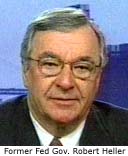|
January NAPM dips again
|
 |
February 1, 2000: 11:35 a.m. ET
Manufacturing activity falls for fourth month in row; construction spending up
|
NEW YORK (CNNfn) - U.S. manufacturing activity eased for a fourth straight month in January, though prices paid for materials rose to a near five-year high, a trade association report showed Tuesday -- suggesting producers are still churning out lots of goods, and paying their suppliers more to do it.
Construction spending, meanwhile, advanced at a faster-than-expected pace, according to a separate, government-issued report.
The National Association of Purchasing Management said its index of manufacturing activity dipped to 56.3 in January from a revised 56.8 in December; slightly above the 56 reading expected by analysts.
The "prices paid" component -- a measure of costs -- rose to 72.6 from a revised 68.3 in January. That's the highest for the index since a 74.5 reading in April 1995.
Even with the decline, manufacturing activity still expanded for the 12th straight month in January, indicating demand at home and abroad for U.S. goods isn't slowing down. The overall index has been higher than 50 -- the benchmark for manufacturing expansion -- since declining in December 1998 to 45.3. That was the lowest since May 1991, the end of the last recession.
Strong manufacturing output
The numbers "are consistent with a recovering manufacturing sector, with little indication of any slowdown in the post-Y2K period," said Steven Wood, an economist with Banc of America Securities in San Francisco. "For the FOMC, with few signs of slowing economic activity outside of housing, a rebounding manufacturing sector will keep the pressure on for higher rates."
The report is compiled by surveying purchasing managers at the nation's factories and assembly plants.
 Both stocks and bonds shrugged off the numbers as investors concluded that the U.S. economy will likely be reined in anyway by a rate increase from the Fed. Fed officials are widely expected to announce a quarter-point rate increase at the conclusion of their two-day meeting Wednesday. Both stocks and bonds shrugged off the numbers as investors concluded that the U.S. economy will likely be reined in anyway by a rate increase from the Fed. Fed officials are widely expected to announce a quarter-point rate increase at the conclusion of their two-day meeting Wednesday.
Robert Heller, former Fed Governor and current President of the International Payments Institute, told CNNfn that the NAPM numbers were just another example of how exuberant the U.S. economy is, suggesting the Fed will raise rates at least once more to cool growth. (193KB WAV) (193KB AIFF)
The numbers and the Fed's policy meeting both coincided with the economy's triumphant entry into its 107th and record month of uninterrupted expansion. Previously, the longest stretch of continuous economic growth occurred during the 1960s, when the U.S. economy was fueled by the United States' ongoing war effort in Vietnam.
New orders on the rise
The NAPM, an organization that provides information and resources for the purchasing profession, surveys some 350 of its 45,000 members each month to track economic activity in 20 industries across the United States. Purchasing managers are the people who buy and sell the goods and services a company needs to make money.
NAPM also calculates components based on levels of production, new orders, deliveries, inventories and employment among its members, offering different perspectives on the progress of the economy.
Its new orders index, which measures current demand, rose to 60.4 in January from 59.6 in December. Its production index, which measures current manufacturing output, slipped to 55.9 from 59, while its index of order backlogs rose to 52 from 50.
Its suppliers' delivery index, which measures how much demand there is from clients to receive their goods, fell to 55.2 from 56.7. Its inventory index, another gauge of pent-up demand, rose to 53.4 from 47.8, while its employment index, which measures companies' hiring plans as well as labor market conditions, rose to 54.3 from 52.2.
Construction spending rises
In a separate report, the Commerce Department said construction spending rose 2 percent in December, the same pace as in November and well above analysts' forecasts of a 0.2 percent gain. Commerce originally reported November's construction spending at 2.6 percent.
"It appears that the sector as a whole will bring significant momentum into 2000 despite the upward trend in interest rates," said Rick MacDonald, a markets analyst with Standard & Poor's MMS. 
|
|
|
|
|
 |

|

